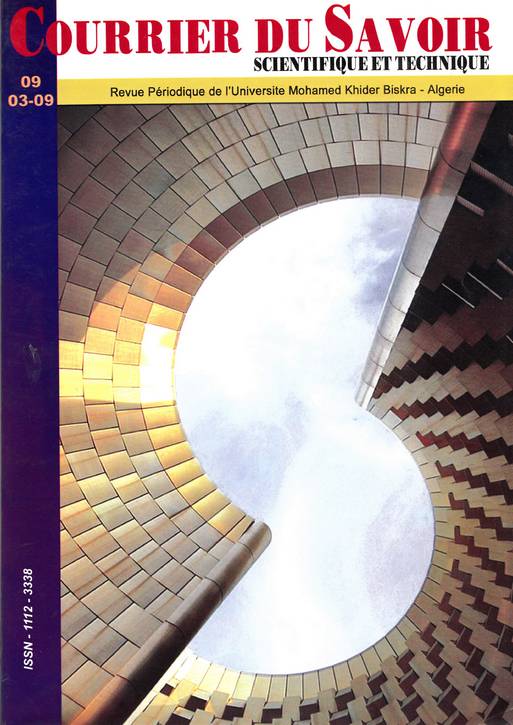EXPERIMENTAL COMPARATIVE STUDY OF SIPHON SPILLWAY AND OVER-FLOW SPILLWAY Etude expérimentale comparative entre les déversoirs en siphon et a écoulement libre
الملخص
Two types of spillways in physical models were tested. The first one is a weir considered as an over-flow spillway with
Creager profile, the second is a siphon spillway with the same longitudinal profile. Concerning the siphon, the study
recognised a clear distinction for no complete prime areas relating to low heads and complete prime areas for the remainder of
the values of heads applied to the level upstream.
The field of convenience of the siphon spillway compared to the weir was defined.
The experimentation allowed also proposing two relationships between flow over a weir and the siphon for the same range of
measured heads.
Deux types de modèles physiques de déversoirs ont été testés. Le premier est à écoulement libre de profil Creager, tandis que
le second est un siphon de même profil que le premier. En ce qui concerne le siphon, l’étude a pu montrer une nette distinction
entre les sections de l’écoulement à amorçage partielle liées aux faibles charges et les sections à amorçage plein ou complet les
autres valeurs de charges appliquées à l’aval. Comparé au déversoir, les conditions les plus avantageuses pour le siphon ont été
définies. L’étude expérimentale a pu conduire à l’établissement de deux relations empiriques liant l’écoulement franchissant le
déversoir et celui du siphon pour la même gamme de charges.
المراجع
100
4, Wilmington Media, UK.
[9] Houichi, L. (2007). ″ Ouvrages d’évacuation ″.
Doctorate Thesis, University of Batna, Algeria.
[10] Ouamane, A. Lempérière, F. (2006). ″Nouvelle
conception de déversoir pour l’accroissement de la
capacité des retenues des barrages″. Colloque
International sur la Protection et la préservation des
ressources en eau. Blida. Algérie
[11] Roberson, J.A.,Cassidy, J.J., Chaudhry,M.H.(1998).
″Hydraulic engineering″, Second edition. John Wiley
& Sons, New York, USA.
[12] Rousselier,M., Blanchet, P. (1951). ″Some realizations
of siphons″, ICOLD, 4th congress, New Delhi, India.
[13] Vischer, D.L., Hager,W.H. (1997). ″Dam hydraulics″,
John Wiley and Sons Ltd, England.[1] Bessonneau, M., Theret, B. (1979). ″Automatic flap
gate spillways and siphon spillways- Comparaison and
advantages of both systems″, ICOLD, 13th
congress,
New Delhi, India.
[2] Bollrich, G. (2000). ″Technische Hydromechanik″,
Band 1, 4. Auflage, Verlag fur Bauwesen Berlin.
Germany.
[3] Chow,V.T. (1981). ″Open-Channel Hydraulics ″,
International Student Edition, McGraw-Hill, 17th
Printing, Tokyo,China.
[4] Creager, W.P. (1929). ″Engineering of Masonry
Dams″. John Wiley & Sons, New York, USA.
[5] Drouhin, G., Mallet, Ch. and Pacquant. J. (1951).
″Contribution to the study of the rate of flow and the
determination of flood discharge″. ICOLD, 4th
congress, New Delhi, India.
[6] Govinda, Rao,N.S. (1962). ″Hydraulics″, Asia
publishing house, India.
[7] Houichi, L., Ghassan, I., Achour, B. (2006).″
Experiments for the discharge capacity of the siphon
spillway having the Creager-Ofitserov profile″.
International journal of fluid mechanics research,
Volume33, Number5, Begell house, Inc.,USA.
[8] Houichi, L., Achour, B. (2007).″ Flow depth
computation at the toe of an overflow dam in steeply
sloping case″. Dam Engineering, Volume XVII, Issue


